Curtiss-Wright AT-9 Jeep
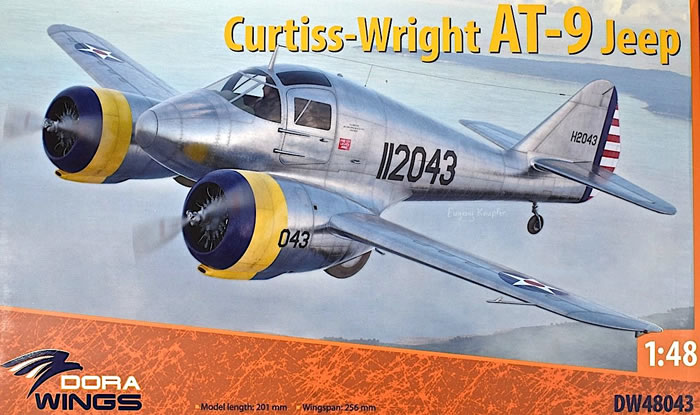
Dora Wings, 1/48 scale
S
u m m a r y : |
Description and Item No.: |
Dora Wings Kit No.DW48043 - Curtiss-Wright AT-9 Jeep |
Contents and Media: |
120 parts in light grey styrene, 7 in clear, one large PE fret, and one decal sheet with markings for 4 airframes. |
Price: |
GBP£27.99 EU Price (GBP £23.22 Export Price) plus shipping at Hannants |
Scale: |
1/48 |
Review Type: |
First Look |
Advantages: |
High level of detail; high quality and fine surface textures; sensible parts breakdown. |
Disadvantages: |
A few assemblies (engine mounts and cowls) that will require a little extra attention. |
Recommendation: |
There’s a lot to like in this box! |
Reviewed by John Miller

The Curtiss-Wright AT-9 Jeep was a twin-engine advanced trainer aircraft used by the United States during WWII to bridge the gap between single-engined trainers and twin-engine combat aircraft. The AT-9 had a low-wing cantilever monoplane configuration, retractable landing gear, and was powered by two Lycoming R-680-9 radial engines.
Development
Curtiss-Wright anticipated the requirement for this type of "high-performance" aircraft and designed the Curtiss-Wright CW-25, a twin-engine trainer, which possessed the take-off and landing characteristics of a light bomber. Using the same basic design as the larger Cessna AT-17 Bobcat, the new CW-25 was designed to simulate the demands of multi-engine operations.
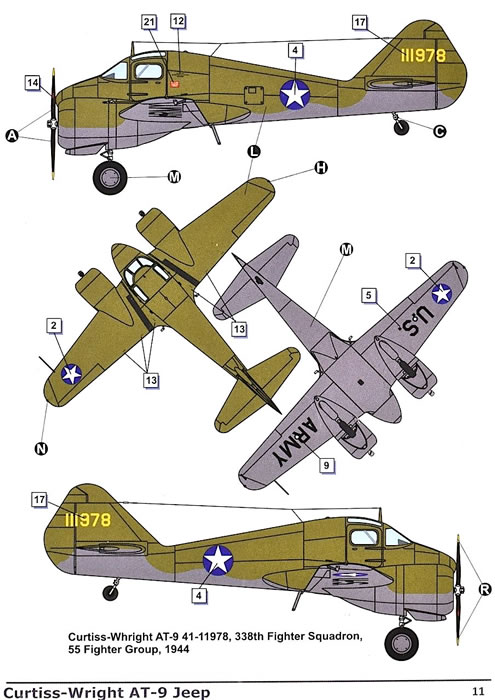
The design featured a small layout, grouping two Lycoming R-680-9 radial engines forward and using a retractable tailwheel landing gear to achieve the performance necessary to meet the requirements of an advanced trainer. The single CW-25 prototype acquired for evaluation had a welded steel-tube fuselage structure with the wings, fuselage and tail unit fabric-covered.
Operational History
The first prototype Model 25 flew in 1941 and the production version entered service as the AT-9 in 1942. Named the "Fledgling" by Curtiss-Wright, it commonly became known as the "Jeep" in the United States Army Air Forces (USAAF). The prototype CW-25 had a fabric-covered steel tube fuselage and fabric-covered wings and tail units, but production AT-9s were of stressed metal skin construction.
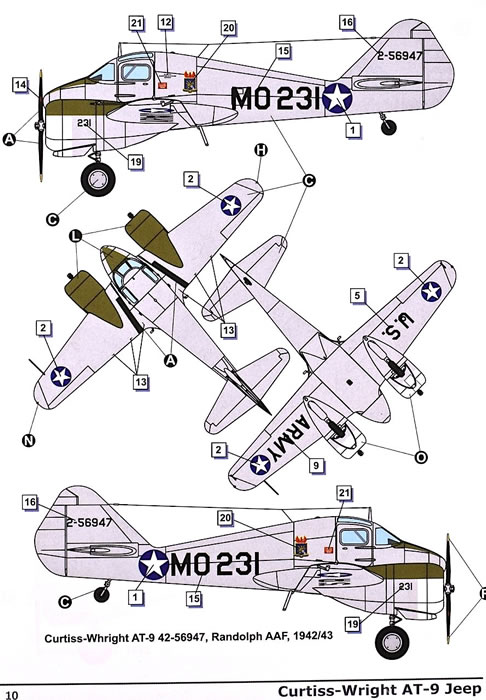
The AT-9 was purposely designed to be less stable and proved to be difficult to fly or land, which made it particularly suitable for teaching new pilots to cope with the demanding flight characteristics of a new generation of high-performance, multi-engined aircraft such as the Martin B-26 Marauder and Lockheed P-38 Lightning.
A total of 491 AT-9s were built before production ended and a new production run of 300 of the generally similar AT-9A commenced. Because of its difficult flying characteristics the AT-9 was not offered for sale to civilians after the war, although many non-flying examples were given to ground schools for training purposes.
One AT-9 survives today on permanent display at the National Museum of the United States Air Force in Dayton, Ohio. This aircraft required extensive restoration, and was the product of the museum staff incorporating two incomplete airframes along with parts fabricated on site. A second airframe is rumoured to have been recovered from a crash site in 2003 and turned over to the Pima Air and Space Museum for restoration. This has not been verified.
(Edited from Wikipedia)
The Kit:
In the lidded box we've come to expect from this manufacturer are six light grey sprues, one clear sprue with 7 parts, one large PE fret, masks, and decals. The initial impression is that of a limited production kit but, upon closer inspection, the level of detail and fidelity of the parts puts the kit a few steps beyond “limited production.” This kit will build into a very nice model, indeed.
Surface details are scale appropriate and the inscribed lines are even and crisp. The sprue gates are small and strategically located, which is always appreciated by this builder. Moreover, even the smaller parts are relatively free of flash suggesting less work will be required for clean up.
Construction starts with the cockpit (‘magine that) and here Dora Wings decided to provide the cockpit side panels as separate parts that glue into the fuselage halves-interesting. The rest of the cockpit is nicely detailed with dual rudder pedal assemblies and multi-part seats, complete with PE harnesses.
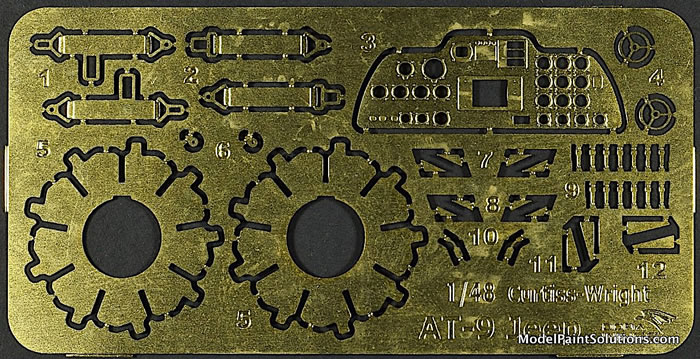
Multiple PE levers are provided for the centre console and an acetate underlay (with instruments) is provided for the PE main panel. This should result in a very convincing cockpit when complete.
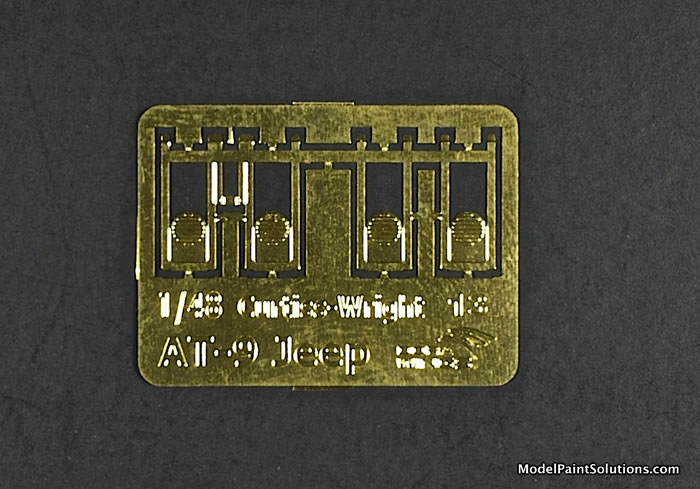
Once the cockpit is trapped between the fuselage halves, the windscreen/upper decking and doors (left and right) are added. The doors don’t appear to be posable in the open position without modification, which doesn’t appear too difficult for those wanting that open cockpit look.
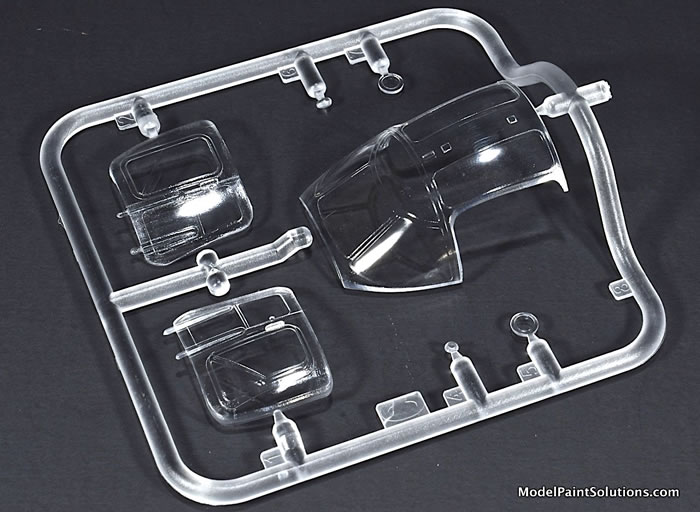
Both the horizontal stabilizers, posable elevators, and posable ailerons are all comprised of halves. The wing is composed of a single piece, full-span lower piece with left and right upper halves.
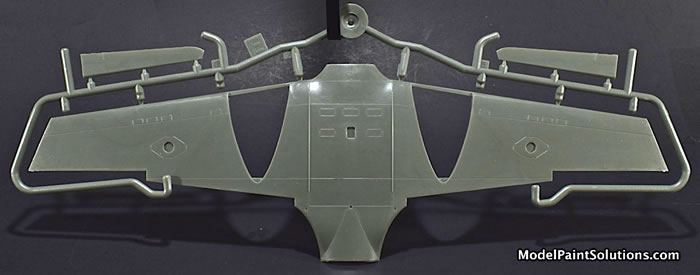
The landing gear components are crisply moulded and utilize single-piece main wheels/tires. The main gear legs are assembled onto their respective wheel well sub-assemblies complete with detailed side walls; nice. The main gear assemblies glue onto the lower wing and are then covered by left and right lower cowl pieces.
The nicely molded radials complete with push rods and ignition collars are next. The super-detailers will be tempted to add ignition wires etc as it will be well exposed when the model is assembled. The rear of each engine has a PE heat shield. The engines attach by very realistic, scale engine mounts and it’s this juncture of the build that I’d be keeping an eye on. In addition to the 2-piece engine mount, the multi-stack exhaust system, each composed of four pieces, is also joined to each assembly at this stage. I suspect a lot of test fitting will be in order here.
With the engines glued in place, the cowls, each composed of 3 pieces, are next up. I would keep a close eye on the fit of the multi-part cowls to ensure the final result has the same smooth contours as the 1/1 versions.
Addition of the nicely moulded, two-bladed props and various airframe details (steps, hinges, pitot tube) completes the build.
Markings:
The decals, by Decograph, are crisply printed with good registration and color density.
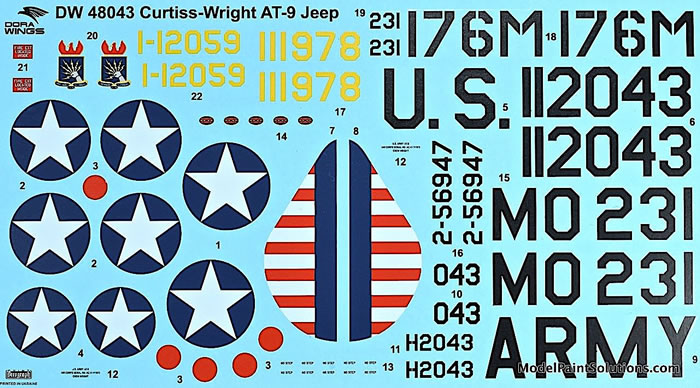
Markings are provided for four airframes as follows:
-
Curtiss-Wright AT-9, 41-12043, 556th School Squadron. Crashed on May 27th, 1942.
-
Curtiss-Wright AT-9, 41-12059, Lubbock AAF, 1942/43.
-
Curtiss-Wright AT-9, 42-56947, Randolph AAF, 1942/43.
-
Curtiss-Wright AT-9, 41-11978, 338th Fighter Squadron, 55th Fighter Group, 1944.
The AT-9 was a very sleek airplane for it’s time and the folks at Dora Wings appear to have a done an admirable job in replicating it’s svelte airframe in 1/48th scale. Like the 1/1 “Jeep,” this is going to be a very nice-looking model when assembled. I suspect there will be a few assemblies (engine mounts and cowls) that will require a little extra attention.
That said, the surface details are nicely rendered, the cockpit and engine details are adequate for the scale, and the crisply printed decals provide markings for four colorful airframes.
There’s a lot to like in this box.
Highly recommended!
John
For more on this review visit Modelpaintsolutions.com:
https://modelpaintsol.com/reviews/dora-wings-48-curtis-wright-at-9-jeep-48043
Review Text and Images Copyright © 2022 by John Miller/Model Paint Solutions
Page Created 10 February, 2022
Last updated
10 February, 2022
Back to HyperScale Main Page
Back to Reviews Page

|
Home
| What's New |
Features |
Gallery |
Reviews |
Reference |
Forum |
Search